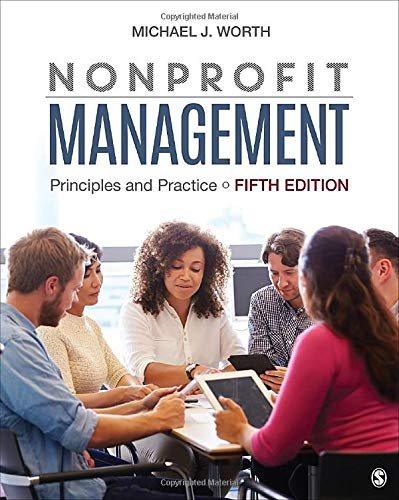Founded in 1901, Sweet Briar College, in Virginia, had provided higher education to generations of women by
Question:
Founded in 1901, Sweet Briar College, in Virginia, had provided higher education to generations of women by 2015. With a campus of 3,250 acres in the foothills of the Blue Ridge Mountains, complete with a stable, boathouse, and 18 miles of trails, the college long had enjoyed strong loyalty among its alumni
(Stolberg, 2015).
Members of the Sweet Briar community were shocked when the Board of Trustees announced abruptly in March 2015 that the college would be closed at the end of the academic year. Although the college had an
$84-million endowment, the board explained that it would not be sufficient to meet the institution's future financial needs (Anderson & Svrluga, 2015). Enrollment had declined to just 532 students on campus.
Much of the endowment was restricted to specific purposes and could not be accessed to meet general operating expenses. The board said there was no other decision that could be reached (Stolberg, 2015).
Opposition to the board's decision came swiftly from students, faculty, and alumnae. A group of alumnae created a group called Saving Sweet Briar, demanding that the college remain open and that the board and president step down. Some challenged the integrity of the board's decision, noting that it had amended its bylaws just days before the closure vote to permit a smaller number of trustees to make decisions (“More Scrutiny of Decision to Close Sweet Briar,” 2015). The attorney for the county in which the college was located asked the court to block the closure and appoint a special fiduciary to prevent the existing board and president from misusing the college's remaining assets (McCambridge, 2015a).
The college had been founded through the will of Indiana Fletcher Williams. Those opposing the closure argued that the board was violating its fiduciary responsibilities under the terms of his will. One court ruled against them on that point, saying that Sweet Briar was in fact a corporation, so the law governing trusts did not apply. That decision was quickly overturned by the Virginia Supreme Court, which ruled that trust law could indeed be applied and sent the case back down to the lower court to handle. However, the Supreme Court's decision did not resolve the underlying question of whether the board could close Sweet Briar.
Meanwhile, what might have been the last commencement had taken place, it was the beginning of summer, and time was running out. Sweet Briar's faculty and current students did not know whether the college would reopen in the fall or not and no freshmen class had been enrolled for the new academic year
(Svrluga, 2015).
The Attorney General of Virginia initiated an effort to negotiate a solution, which the court approved in late June 2015. Under the terms of the court order, all of the current board members resigned and were replaced. Phillip Stone, who had successfully led another college through financial difficulties, was selected to become the new president at Sweet Briar. The court permitted the new board to use $16 million of restricted endowment funds to meet operating costs for the next year (Stolberg, 2015). Alumni pledged $12 million in new resources and announced a campaign to raise an additional $120 million (Stolberg, 2015).
Sweet Briar would live at least for one more year....................
Questions
1. Although the Sweet Briar College board was not found to have acted illegally, which of the legal responsibilities of boards discussed in this chapter were most relevant to its actions in deciding to close the college?
2. Should the board of Sweet Briar College have taken actions earlier to avoid the financial pressures that led it to consider closure? If so, what actions might the board have considered?
3. Do you think that boards are more likely to face more external scrutiny and pressure regarding their decisions in the future? If so, what accounts for that change?
Step by Step Answer:

Nonprofit Management Principles And Practice
ISBN: 9781506396866
5th Edition
Authors: Michael J. Worth





